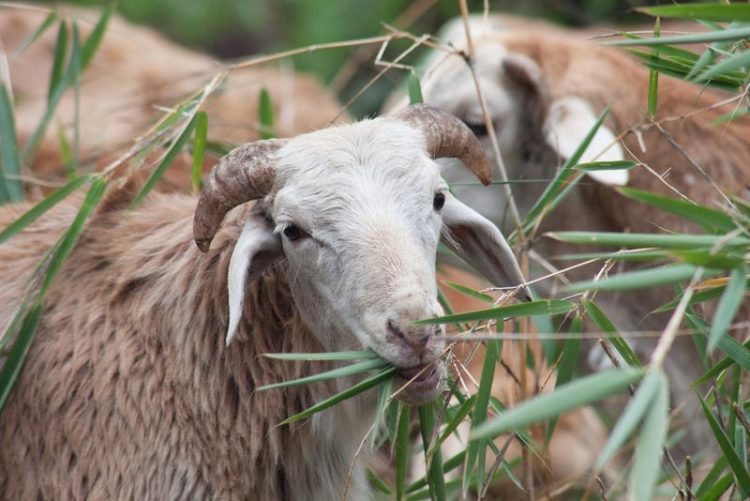Better livestock diets to combat climate change and improve food security

Better diets for livestock could reduce greenhouse gas emissions. International Livestock Research Institute (ILRI)
Livestock production is responsible for 12% of human-related greenhouse gas emissions, primarily coming from land use change and deforestation caused by expansion of agriculture, as well as methane released by the animals themselves, with a lesser amount coming from manure management and feed production.
“There is a lot of discussion about reduction of meat in the diets as a way to reduce emissions,” says IIASA researcher Petr Havlík, who led the study. “But our results show that targeting the production side of agriculture is a much more efficient way to reduce greenhouse gas emissions.”
A new study published in the journal Proceedings of the National Academy of Sciences shows that within the current systems, farmers would find it more profitable in coming years to expand livestock production in mixed systems—where livestock are fed on both grass as well as higher quality feed—rather than in pure grass-based systems. This development, would lead to a 23% reduction of emissions from land use change in the next two decades without any explicit climate mitigation policy.
Cows, sheep, and goats grow more quickly and produce more milk when they eat energy-rich diets that include grain supplements or improved forages. This means that more livestock can be raised on less land, and with fewer emissions per pound of meat or milk produced.
The new study projects that the increasing cost of land and continued yield increases in the crop sector will lead to shifts to richer animal diets in the future. Such diets are efficient not only from the perspective of greenhouse gas reduction, but also from farm profit maximization and food production.
At a moderate price of US$10 per ton of carbon dioxide equivalent, livestock system transitions within a given region, together with international relocation of production to regions with the most efficient livestock systems could also reduce the total emissions from agriculture and land use change by 25%. Most of the savings would come from avoided land use change.
Havlík says, “From the livestock sector perspective, limiting land use change seems the cheapest option both in terms of the economic cost and in terms of impact on food availability.”
Previous work by the group produced a detailed database highlighting the differences in the efficiency and greenhouse gas emissions of different livestock production systems. The new study adds to this by examining the economic potential for a transition to more efficient systems as a mitigation measure, and which policies would be the most effective for cutting greenhouse gas emissions, while also maintaining food availability.
The new study also introduces a new metric for measuring the costs of climate measures for agricultural systems, the Total Abatement Calorie Cost (TACC), which complements the pure economic metric known as “marginal abatement cost” while also capturing the impacts of mitigation measures on food security. Mario Herrero, a co-author of the study and a researcher at CSIRO, IIASA’s Australian National Member Organization, says, “Applying current metrics could lead to mitigation, but also food insecurity in developing countries, because it ignores the social cost of policies that focus just on greenhouse gas abatement.. So we developed a new metric which tells you how consumption would be affected as a result of mitigating greenhouse gas emissions.”
Changing livestock production systems remains a challenge. The researchers say that policies to provide education and market access are the keys for enabling change. In addition, they note that safeguards are needed to insure that the intensified agricultural production does not lead to environmental damage or reduce animal well-being.
Reference
Havlík P, Valin H, Herrero M, Obersteiner M, Schmid E, Rufino MC, Mosnier A, Thornton P, Boettcher, H, Conant RT, Frank S, Fritz S, Fuss S, Kraxner, F, Notenbaert, A. (2014). Climate change mitigation through livestock system transitions. Proceedings of the National Academy of Sciences www.pnas.org/cgi/doi/10.1073/pnas.1308044111
For more information please contact:
Petr Havlík
Research Scholar
Ecosystems Services and Management
+43(0) 2236 807 511
havlikpt@iiasa.ac.at
Katherine Leitzell
IIASA Press Office
Tel: +43 2236 807 316
Mob: +43 676 83 807 316
leitzell@iiasa.ac.at
About IIASA:
IIASA is an international scientific institute that conducts research into the critical issues of global environmental, economic, technological, and social change that we face in the twenty-first century. Our findings provide valuable options to policy makers to shape the future of our changing world. IIASA is independent and funded by scientific institutions in Africa, the Americas, Asia, Oceania, and Europe. www.iiasa.ac.at
Media Contact
All latest news from the category: Agricultural and Forestry Science
Newest articles

New model of neuronal circuit provides insight on eye movement
Working with week-old zebrafish larva, researchers at Weill Cornell Medicine and colleagues decoded how the connections formed by a network of neurons in the brainstem guide the fishes’ gaze. The…

Innovative protocol maps NMDA receptors in Alzheimer’s-Affected brains
Researchers from the Institute for Neurosciences (IN), a joint center of the Miguel Hernández University of Elche (UMH) and the Spanish National Research Council (CSIC), who are also part of…

New insights into sleep
…uncover key mechanisms related to cognitive function. Discovery suggests broad implications for giving brain a boost. While it’s well known that sleep enhances cognitive performance, the underlying neural mechanisms, particularly…



